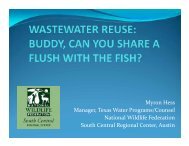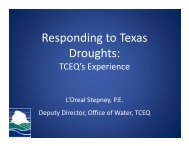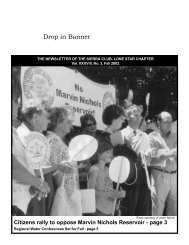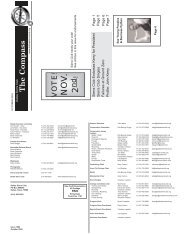comments in PDF - Lone Star Chapter, Sierra Club
comments in PDF - Lone Star Chapter, Sierra Club
comments in PDF - Lone Star Chapter, Sierra Club
You also want an ePaper? Increase the reach of your titles
YUMPU automatically turns print PDFs into web optimized ePapers that Google loves.
used with a non-motorized and mechanized hand on the land for non-native <strong>in</strong>vasive<br />
plant species control.<br />
8) Wilderness – Much of GMNP is designated Wilderness or qualifies for designation<br />
as Wilderness. The maximum landscape that qualifies for Wilderness must be<br />
proposed by NPS to the U.S. Congress for designation as Wilderness. Ensure that<br />
human effects (no <strong>in</strong>stallations and structures) are kept to a m<strong>in</strong>imum. Wilderness<br />
management must keep <strong>in</strong> m<strong>in</strong>d the m<strong>in</strong>imum tool requirement. The key for GMNP is<br />
Wilderness appreciation for the fragile ecosystems of this small, beautiful, and unique<br />
Wilderness national park. Ma<strong>in</strong>ta<strong>in</strong> the park experiences that are already available <strong>in</strong><br />
the Wilderness park and do not try to make GMNP all th<strong>in</strong>gs for all visitors. Do not<br />
change the Wilderness focus simply due to evolv<strong>in</strong>g patterns of public use. Change for<br />
the sake of change does not make sense. GMNP is not Yosemite or Grand Canyon<br />
National Parks. The management of the Guads as a Wilderness park is right and<br />
should be kept that way.<br />
Why the National Park Service Plans and Summary<br />
1) Page v, Why the National Park Service Plans, NPS states “The plann<strong>in</strong>g process<br />
ensures that decision-makers have adequate <strong>in</strong>formation about benefits, costs, and<br />
impacts on natural and cultural resources, visitor use and experience, and<br />
socioeconomic conditions.” The NPS should remember that the “public” also must have<br />
this <strong>in</strong>formation. That is what the National Environmental Policy Act (NEPA) and<br />
Council on Environmental Quality (CEQ) NEPA implement<strong>in</strong>g regulations requires and<br />
why NPS must follow NEPA meticulously. NEPA is the only opportunity for the public to<br />
f<strong>in</strong>d out about, review, comment on, and understand what is proposed for GMNP, which<br />
it owns.<br />
2) Page vii, Summary, Park History and Plann<strong>in</strong>g, NPS uses the phrase “<strong>in</strong>terested<br />
stakeholders”. NPS must remember that the public is the “owner” of NPS and GMNP<br />
and therefore it is the public, not only so-called stakeholders, that must be looked to for<br />
review, comment, and understand<strong>in</strong>g of this proposal.<br />
The NPS has expressed a concern about becom<strong>in</strong>g irrelevant to the public. NPS<br />
should expla<strong>in</strong> what it means by this and state how this concern has shaped this draft<br />
GMP/EIS.<br />
3) Page x, Preferred Alternative and page xii Alternative C, the NPS states “The<br />
preferred alternative would have mostly m<strong>in</strong>or, long-term, adverse impacts on most<br />
natural resource impact topics, primarily because about 200 acres of currently<br />
undeveloped land would be permanently converted to developed park facilities” and<br />
“Alternative C would have mostly m<strong>in</strong>or, long-term adverse impacts on most natural<br />
resource impact topics, primarily because about 500 acres of currently undeveloped<br />
land would be permanently converted to developed park facilities.” The <strong>Sierra</strong> <strong>Club</strong><br />
does not consider the loss of 200 or 500 acres of natural habitat with function<strong>in</strong>g natural<br />
3







